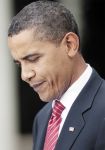by Ben Feller
WASHINGTON (AP)—The same president who aggressively harnesses the power of the press to promote his agenda has taken to lacing his comments with criticisms of the media, with no bigger target than the gabby culture of cable television.
President Barack Obama’s critique is biting: The media prefer conflict over cooperation, encourage bad behavior and weaken the ability of leaders to help the nation.
 |
| MAXIMUM EXPOSURE—In this Oct. 2 photo, President Barack Obama pauses while speaking to members of the media in the Rose Garden of the White House. |
The White House’s attempt to discredit Fox News as an arm of the Republican Party may have been getting the headlines, but it is only one recent window into Obama’s already complex and crafty relationship with those who cover him.
All of Obama’s frustration comes as he not only welcomes the ratings-mad media’s constant demand for his presence, but also aggressively seeks maximum exposure to serve his own agenda.
He went on Letterman and Leno. He’s held as many nightly news conferences in his first six months as George W. Bush and Bill Clinton did in eight years, and conducted far more interviews than either had at this point in their presidencies. He is the first Oval Office occupant to do five Sunday morning talk shows in a one day.
In essence, Obama’s strategy is not to tame the media to his liking or blame it for his troubles. It is both.
Obama defends independent reporting as vital to society. He touts the value of providing more openness to the public and accountability by government—indeed, it was one of his more prominent campaign promises.
And then, he’s the media’s chief critic.
Lamenting the rise of instant commentary at a memorial for news anchor Walter Cronkite, Obama said that “What happened today?” is now replaced with “Who won today?”
“The public debate cheapens,” he said. “The public trust falters. We fail to understand our world or one another as well as we should—and that has real consequences in our own lives in the life of our nation.”
Sometimes the compliments and condemnation come in practically the same breath.
“The 24-hour news cycle and cable television and blogs and all this, they focus on the most extreme elements on both sides,” Obama told CBS News, echoing those comments in the three more network interviews that made up his Sunday show blitz last month.
Blaming the media is almost tradition among politicians. It helps Obama by bonding him with his audience against a common target: the influential press, which many people consider to be biased or untrustworthy. But it does carry a risk of backfiring by elevating Obama’s critics or making the White House look petty for pinning its problems on the press corps.
The president is sophisticated about what attracts coverage, what’s in the media each day, and why. Unlike Bush, who publicly claimed little interest in news from papers or TV, Obama dives into it.
Aides say he reads four or five newspapers each morning. He catches bits of TV coverage on the sets around the Oval Office. Obama also goes online, has articles flagged for him by staff, reads news magazines on Air Force One and likes to hear which stories have aides buzzing.
So though he often does not differentiate in his criticism among the “media,” he’s well aware it is actually a diverse mix of print, TV, radio, and Web that is hardly homogenous in its choices about what story to cover or how.
But with more than 70 percent of Americans saying television is their main source of national and international news, according to a Pew Research survey, it’s clear that Obama and his advisers are most riled by what’s on nonstop cable.
With its hours and hours of TV time to fill, cable news and punditry can whip up public debate and then cause spillover coverage in other forms of media.
Senior White House leaders still mock the front-page coverage given to whether Obama’s back-to-school speech to the nation’s students was an attempt to indoctrinate them. Obama was openly incredulous over the media’s minute-by-minute anticipation of Obama’s so-called “beer summit” with a policeman and a professor at the center of a racial controversy.
And when the president gave a major speech to Congress on health care policy, the coverage for days centered on Joe Wilson, the South Carolina Republican lawmaker who had heckled Obama by shouting “You lie!”
“You’ve got to be careful about them cable networks,” Obama cautioned a man at a Montana town hall who had just told him that cable was his main source of news.
The irritation has reached another level recently over Fox News, which Obama and his aides have brazenly tried to marginalize by calling it a Republican outlet that shouldn’t be treated like a real news network. Yet publicly singling out one news organization is but the most highly publicized push-back from an Obama White House that began back during last year’s campaign building a reputation for aggressively confronting reporters over stories it doesn’t like and using hardball tactics to try to get its way.
Not to be lost in Obama’s pique, however, is that he has a point, said Jill Geisler, a former broadcaster who teaches leadership at the Poynter Institute, a nonprofit school for journalists. Noise makes news. Nuance often does not.
“I think each of us in journalism must ask: Are we contributing to a deeper understanding of complex issues?” she said.
Predictably, Obama’s media coverage has turned more negative since the start of his term.
That reflects the partisan tensions in Washington, setbacks on many of his top agenda items, and the traditional adversarial, watchdog role of the White House press corps.